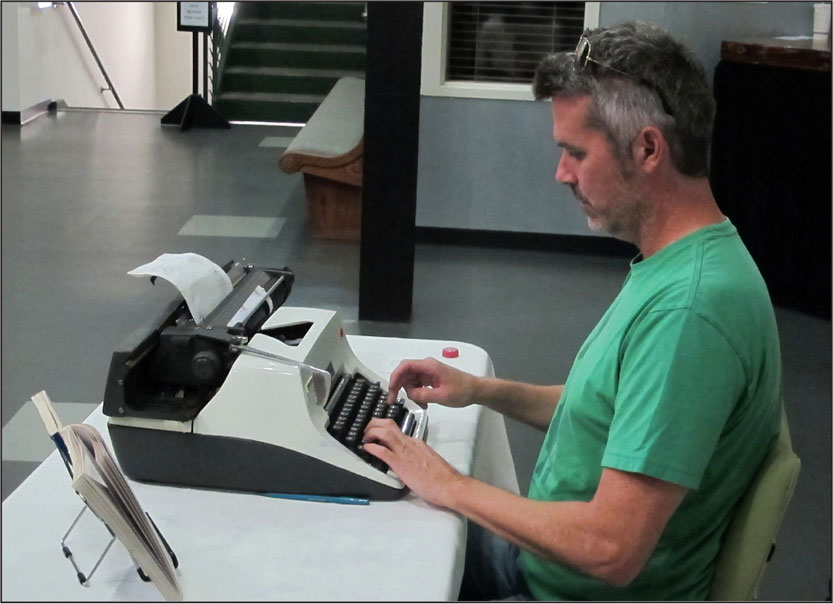
11 Dec Artist Interview: Tim Youd Fetishizes the Typewriter
“Do some living and get yourself a typewriter.”
On a recent Friday night Tim Youd sits in front of a small table at the Grand Central Art Center in Santa Ana typing away on an Olympia SG-3 electric typewriter, shifting his gaze between the Phillip K. Dick novel to his left and the typewriter keys in front of him. When he reaches the bottom of the page he re-inserts the same sheet back in the typewriter and continues typing on what is now a rectangle of dense black ink, by the time we meet Youd the paper is worn through in spots and taped together. This process is part of the Los Angeles artists Typewriter Series in which he plans to type 100 novels in the next five years. More specifically, Youd pays tribute to 100 classics of modern literature while confronting the “fetishization” of the writers instrument by re-typing the entire work, word for word, with the same make and model of typewriter that the original novelist used, in as close to the original location as possible.
What makes the project more than a literary homage is that Youd types the entire novel onto a single sheet of paper, with a blank sheet underneath, repeatedly feeding the same two sheets back into the typewriter. The result is an ink-saturated top piece and a bottom sheet blank save for indentations made by the hundreds of thousands of mechanical keystrokes. These are then framed and presented as a diptych, in a piece of art that echoes the two pages of an open book. Youd also constructs a cardboard model of the writer’s original typewriter, creating an interesting combination of performance art, sculpture and mixed media.
Youd started the Series in February of this year and is currently working on recreating his fifteenth novel of the project, A Scanner Darkly by Phillip K Dick, a few blocks from where the original manuscript was created in a third-story condominium on Civic Center Drive in Santa Ana.
Youd is in his final two weeks at the GCAC and we caught up with him to understand what drives an artist to snub the specter of carpal tunnel for the rhythmic ding of the carriage return, and voluntarily surrender to an activity most of America’s middle-management tries to escape from: sitting at a desk and typing for hours a day.
How did you come up with the idea for this project?
For ten years my art has had to do with text and literature, so this is an area I have explored from many different angles. The reason why I wanted to use the same typewriters is that culturally there is this fetishization of the lives and tools of authors. We elevate [it] to a level that’s higher than the work.
We have turned the typewriter of Hemingway into a religious relic and I am going to use that relic to do the work in an almost absurd way. I am going to re-type the novel, in the location, and re-introduce the idea of the time, the duration and the hard work that goes into creating a piece of art. In a humorous way, not a laugh out loud sort of way, but I do find the whole situation amusing.
There are several layers to this work: You are typing, there is the diptych and there is the sculpture of the typewriter. Did you add layers as you went?
It definitely evolved. Formally, if you open a book it’s a rectangle and a smaller rectangle. Ultimately what these diptychs become is this very formal representation of a book.
The sculptural portrait came along early because I was initially captivated by the fetishization of the author’s tool. Why is it important that Hunter S. Thompson wrote on this kind of typewriter? On the purest level it shouldn’t matter — let the work speak for itself — but we are not purists. I’m not a purist as an artist either.
There are parts that have purity, and that is the diptych piece of it, but there is this whimsical sculpture that is more playful. And there is the performance: the absurdity of just sitting and typing something that’s been typed, I’m not event typing it to be read. The performance would be a failure for me if I were creating something that was legible. I would be failing to take the idea of the absurdity all the way to its conclusion.
You started in February (2013) and you are on your fifteenth novel already. Have you been to fifteen different locations and bought fifteen different typewriters?
I use the same make and model typewriter the author used, so I am always switching typewriters. I have probably used seven or eight typewriters to get to the fifteen. I first started in my studio. For the first [novel] I [used] an IBM Selectric II and typed Hunter S. Thompson’s Fear and Loathing in Las Vegas. Then I did Bukowski’s Women and Philip Roth’s Portnoy’s Complaint.
In May I went to New York for the Pulse Art Fair and coincidentally the Henry Miller Memorial Library was going to do a weeklong celebration of Henry Miller’s life in Brooklyn. They invited me to finish with them, [which] turned into me sitting on a sidewalk in Brooklyn around the corner from Miller’s boyhood home. That was a moment a light bulb when off: there is something fun about this to me.
Do you actually get a sense of the words as you are typing?
I’m pretty engaged in the text, I read it out loud a little bit to myself. I want to be present for it and not lose my sense of what I am doing
How long would you say you are typing per day?
Here I am doing noon to four, I want to make sure I am typing through the month. I don’t want to not be typing. If I am going to come close to five years, I am going to have to do something every month.
Do the works that you select, beyond the logistics of needing to be created on a typewriter, speak to you in some way? Have you read these books in the past?
When it started out I was picking Hunter S. Thompson, Bukowski, Phillip Roth, and Henry Miller. These are all guys I have read pretty deeply, not just one or two of their works, but lots of them. As I branch out it’s going to cause me to look at works or authors that I am not so familiar with or haven’t read as deeply. I try to read the novels before I type them.
Do you have any female authors?
There are some on the list. The meat of the typewriter generation is sort of a boys club so there aren’t as many, because women didn’t have access to publishing the way that men did. I would like to do Sylvia Plath’s The Bell Jar at Smith [College]. I’m planning to do Joan Didion’s Play It as It Lays because that’s her Hollywood story. The Talented Mister Ripley and Strangers on a Train [Patricia Highsmith] are on the list.
Any sort of carpal tunnel?
So far so good, maybe because I change the machines, we’ll see when I get to Gravity’s Rainbow [by Thomas Pynchon], that’s like a thousand pages long.
What would be the highest compliment from someone who saw your work?
Because literature has grabbed me, it’s so much a part of my whole approach [that] If somebody sees what I’m doing and goes home and reads that book that I am typing, that would be pretty cool.
Tim You’d will be typing Dec 11- 13, 15, 17-18, 20, 22, noon-4pm at the Grand Central Art Center, 125 N Broadway, Santa Ana, CA 92701 (714) 567-7233



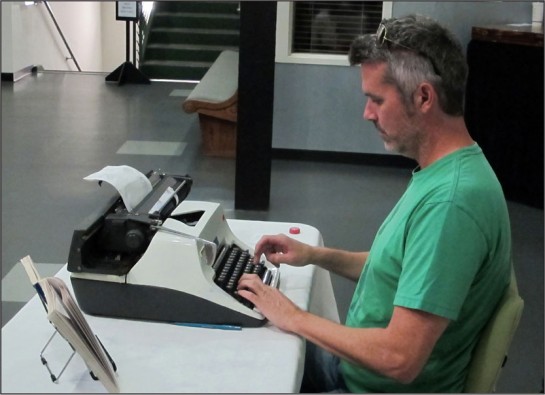
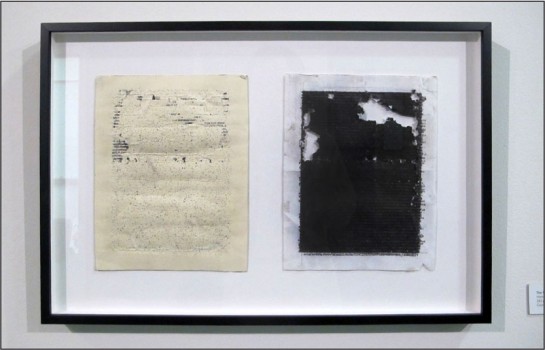
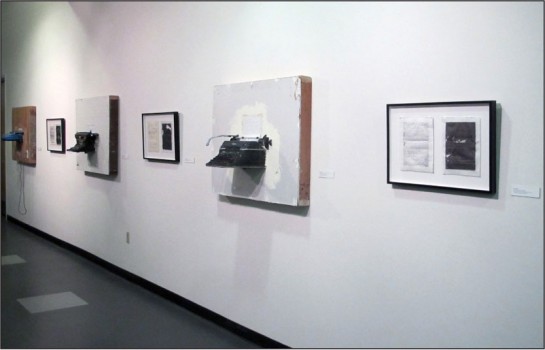
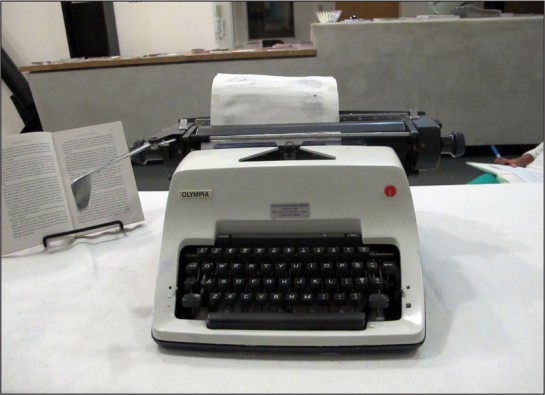

Jim Ward Morris
Posted at 22:15h, 18 DecemberHi Tim Youd,
My name is Jim Ward Morris. I’m an artist (graduated from California Institute of the Arts with a BFA and MFA). I’m working on two different series, one titled “paintings” and the other is titled “words.” The series titled “words” is the one that I want to share with you. For this series (so far) I’m working with a vintage olivetti manual typewriter on paper (8.5X10.5 inches) and on this paper, with this typewriter, I’m typing letters and words (my postmodern influence and the “everything has already been done” idea). These words are so simple they really do not need to say or express any thought or make any statement. They are there completely as a visual reference to a traditional image showing analog letters on natural fiber paper. I’m fine tuning this “words” series towards the idea of using a simple piece of paper with only a few simple typewriter letters on it and having it viewed as an art object (in the same way a painting or sculpture is viewed). My paintings are made with the idea that the painting plane works in relation to the wall plane. Rather than creating an internal illusion of light, my paintings have an outward aesthetic of light. The painting is occupying an actual space, like sculpture, rather than presenting a pictorial illusion of space. My hope is to do the same thing, make the same visual statement with the words as well.
Good luck with your typewriter series and let me know if you would like to stay in touch,
Jim Ward Morris